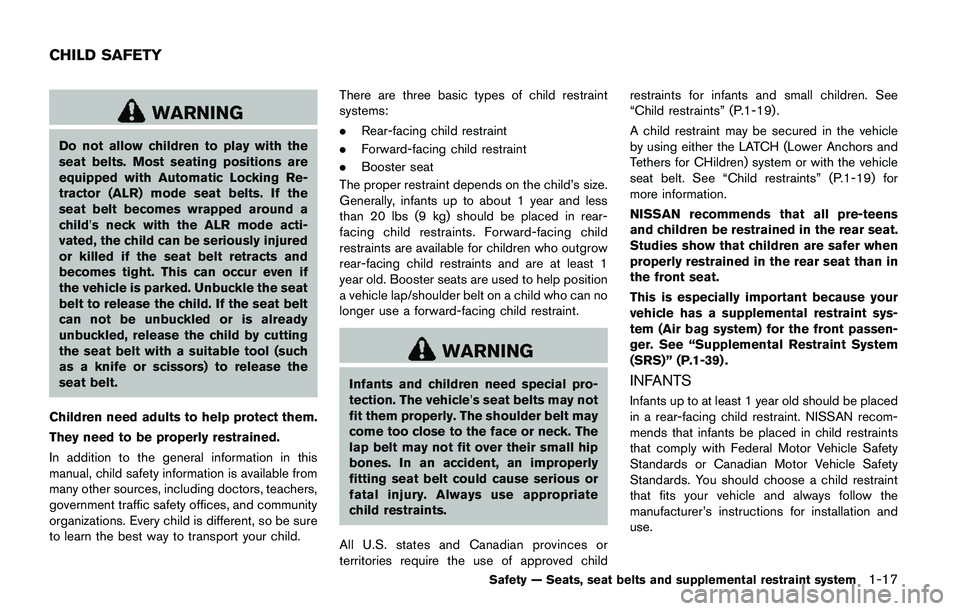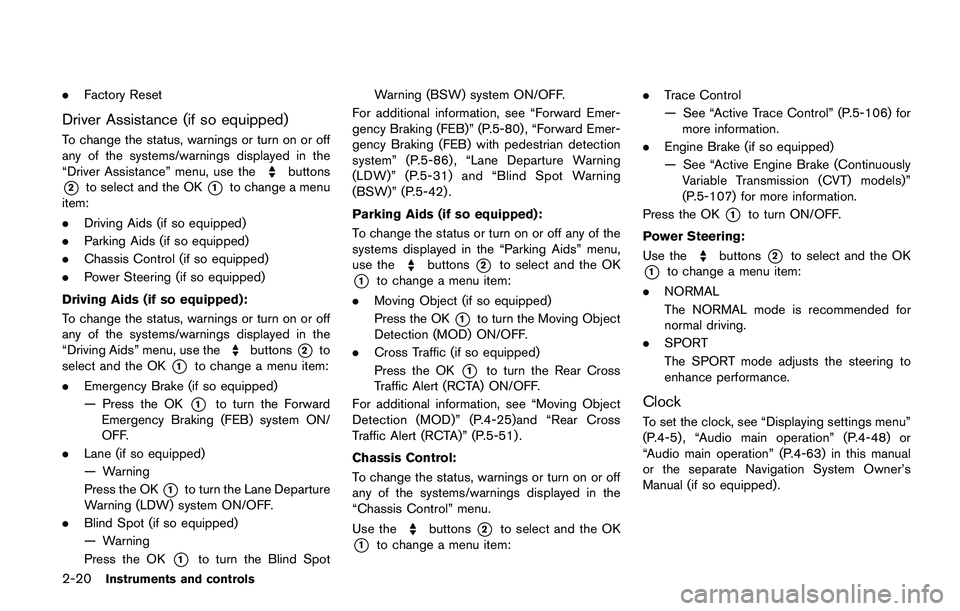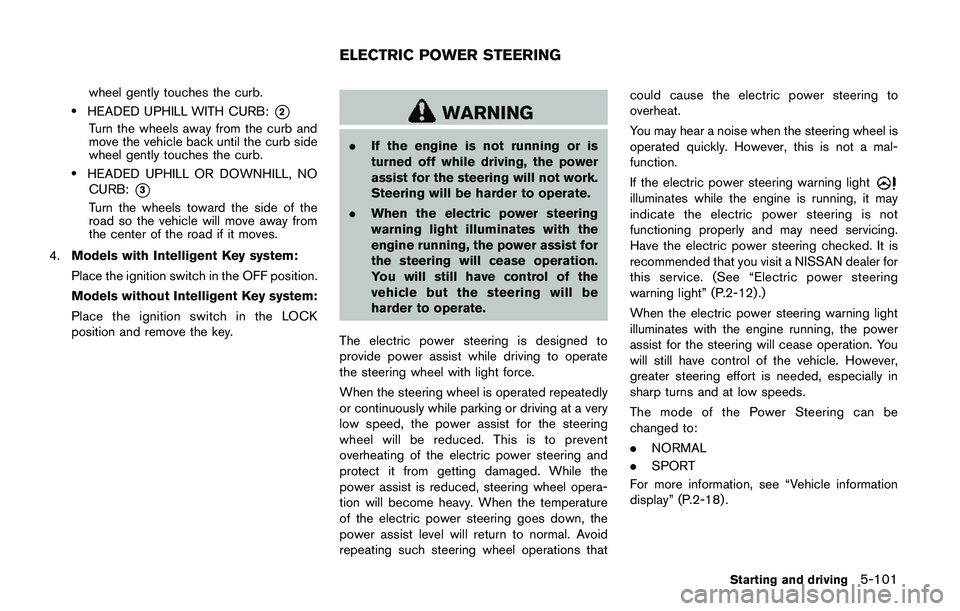sport mode NISSAN QASHQAI 2017 Owner´s Manual
[x] Cancel search | Manufacturer: NISSAN, Model Year: 2017, Model line: QASHQAI, Model: NISSAN QASHQAI 2017Pages: 508, PDF Size: 2.68 MB
Page 36 of 508

WARNING
Do not allow children to play with the
seat belts. Most seating positions are
equipped with Automatic Locking Re-
tractor (ALR) mode seat belts. If the
seat belt becomes wrapped around a
child’s neck with the ALR mode acti-
vated, the child can be seriously injured
or killed if the seat belt retracts and
becomes tight. This can occur even if
the vehicle is parked. Unbuckle the seat
belt to release the child. If the seat belt
can not be unbuckled or is already
unbuckled, release the child by cutting
the seat belt with a suitable tool (such
as a knife or scissors) to release the
seat belt.
Children need adults to help protect them.
They need to be properly restrained.
In addition to the general information in this
manual, child safety information is available from
many other sources, including doctors, teachers,
government traffic safety offices, and community
organizations. Every child is different, so be sure
to learn the best way to transport your child.There are three basic types of child restraint
systems:
.Rear-facing child restraint
.Forward-facing child restraint
.Booster seat
The proper restraint depends on the child’s size.
Generally, infants up to about 1 year and less
than 20 lbs (9 kg) should be placed in rear-
facing child restraints. Forward-facing child
restraints are available for children who outgrow
rear-facing child restraints and are at least 1
year old. Booster seats are used to help position
a vehicle lap/shoulder belt on a child who can no
longer use a forward-facing child restraint.
WARNING
Infants and children need special pro-
tection. The vehicle’s seat belts may not
fit them properly. The shoulder belt may
come too close to the face or neck. The
lap belt may not fit over their small hip
bones. In an accident, an improperly
fitting seat belt could cause serious or
fatal injury. Always use appropriate
child restraints.
All U.S. states and Canadian provinces or
territories require the use of approved childrestraints for infants and small children. See
“Child restraints” (P.1-19) .
A child restraint may be secured in the vehicle
by using either the LATCH (Lower Anchors and
Tethers for CHildren) system or with the vehicle
seat belt. See “Child restraints” (P.1-19) for
more information.
NISSAN recommends that all pre-teens
and children be restrained in the rear seat.
Studies show that children are safer when
properly restrained in the rear seat than in
the front seat.
This is especially important because your
vehicle has a supplemental restraint sys-
tem (Air bag system) for the front passen-
ger. See “Supplemental Restraint System
(SRS)” (P.1-39) .INFANTS
Infants up to at least 1 year old should be placed
in a rear-facing child restraint. NISSAN recom-
mends that infants be placed in child restraints
that comply with Federal Motor Vehicle Safety
Standards or Canadian Motor Vehicle Safety
Standards. You should choose a child restraint
that fits your vehicle and always follow the
manufacturer’s instructions for installation and
use.
Safety — Seats, seat belts and supplemental restraint system1-17
CHILD SAFETY
Page 99 of 508

2-20Instruments and controls
.Factory Reset
Driver Assistance (if so equipped)
To change the status, warnings or turn on or off
any of the systems/warnings displayed in the
“Driver Assistance” menu, use the
buttons
*2to select and the OK*1to change a menu
item:
.Driving Aids (if so equipped)
.Parking Aids (if so equipped)
.Chassis Control (if so equipped)
.Power Steering (if so equipped)
Driving Aids (if so equipped) :
To change the status, warnings or turn on or off
any of the systems/warnings displayed in the
“Driving Aids” menu, use the
buttons*2to
select and the OK
*1to change a menu item:
.Emergency Brake (if so equipped)
— Press the OK
*1to turn the Forward
Emergency Braking (FEB) system ON/
OFF.
.Lane (if so equipped)
— Warning
Press the OK
*1to turn the Lane Departure
Warning (LDW) system ON/OFF.
.Blind Spot (if so equipped)
— Warning
Press the OK
*1to turn the Blind SpotWarning (BSW) system ON/OFF.
For additional information, see “Forward Emer-
gency Braking (FEB)” (P.5-80) , “Forward Emer-
gency Braking (FEB) with pedestrian detection
system” (P.5-86) , “Lane Departure Warning
(LDW)” (P.5-31) and “Blind Spot Warning
(BSW)” (P.5-42).
Parking Aids (if so equipped):
To change the status or turn on or off any of the
systems displayed in the “Parking Aids” menu,
use the
buttons*2to select and the OK
*1to change a menu item:
.Moving Object (if so equipped)
Press the OK
*1to turn the Moving Object
Detection (MOD) ON/OFF.
.Cross Traffic (if so equipped)
Press the OK
*1to turn the Rear Cross
Traffic Alert (RCTA) ON/OFF.
For additional information, see “Moving Object
Detection (MOD)” (P.4-25)and “Rear Cross
Traffic Alert (RCTA)” (P.5-51) .
Chassis Control:
To change the status, warnings or turn on or off
any of the systems/warnings displayed in the
“Chassis Control” menu.
Use the
buttons*2to select and the OK
*1to change a menu item:.Trace Control
— See “Active Trace Control” (P.5-106) for
more information.
.Engine Brake (if so equipped)
— See “Active Engine Brake (Continuously
Variable Transmission (CVT) models)”
(P.5-107) for more information.
Press the OK
*1to turn ON/OFF.
Power Steering:
Use the
buttons*2to select and the OK
*1to change a menu item:
.NORMAL
The NORMAL mode is recommended for
normal driving.
.SPORT
The SPORT mode adjusts the steering to
enhance performance.
Clock
To set the clock, see “Displaying settings menu”
(P.4-5) , “Audio main operation” (P.4-48) or
“Audio main operation” (P.4-63) in this manual
or the separate Navigation System Owner’s
Manual (if so equipped) .
Page 386 of 508

wheel gently touches the curb.
.HEADED UPHILL WITH CURB:*2
Turn the wheels away from the curb and
move the vehicle back until the curb side
wheel gently touches the curb.
.HEADED UPHILL OR DOWNHILL, NO
CURB:
*3
Turn the wheels toward the side of the
road so the vehicle will move away from
the center of the road if it moves.
4.Models with Intelligent Key system:
Place the ignition switch in the OFF position.
Models without Intelligent Key system:
Place the ignition switch in the LOCK
position and remove the key.
WARNING
.If the engine is not running or is
turned off while driving, the power
assist for the steering will not work.
Steering will be harder to operate.
.When the electric power steering
warning light illuminates with the
engine running, the power assist for
the steering will cease operation.
You will still have control of the
vehicle but the steering will be
harder to operate.
The electric power steering is designed to
provide power assist while driving to operate
the steering wheel with light force.
When the steering wheel is operated repeatedly
or continuously while parking or driving at a very
low speed, the power assist for the steering
wheel will be reduced. This is to prevent
overheating of the electric power steering and
protect it from getting damaged. While the
power assist is reduced, steering wheel opera-
tion will become heavy. When the temperature
of the electric power steering goes down, the
power assist level will return to normal. Avoid
repeating such steering wheel operations thatcould cause the electric power steering to
overheat.
You may hear a noise when the steering wheel is
operated quickly. However, this is not a mal-
function.
If the electric power steering warning light
illuminates while the engine is running, it may
indicate the electric power steering is not
functioning properly and may need servicing.
Have the electric power steering checked. It is
recommended that you visit a NISSAN dealer for
this service. (See “Electric power steering
warning light” (P.2-12).)
When the electric power steering warning light
illuminates with the engine running, the power
assist for the steering will cease operation. You
will still have control of the vehicle. However,
greater steering effort is needed, especially in
sharp turns and at low speeds.
The mode of the Power Steering can be
changed to:
.NORMAL
.SPORT
For more information, see “Vehicle information
display” (P.2-18) .
Starting and driving5-101
ELECTRIC POWER STEERING